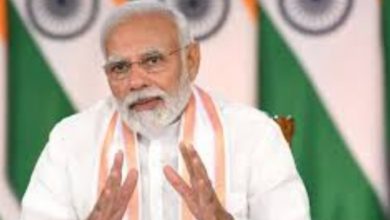Ukraine’s sudden gains prompt new questions for commanders

After Ukraine’s stunning offensive in its northeast drove Russian forces into a chaotic retreat and reshaped the battlefield hundreds of miles, Ukrainian leaders Monday were weighing critical gambles that could determine the near-term course of the war.
Stretching the Ukrainian forces — a military still much smaller and far less equipped than its Russian foe — too far could leave the troops vulnerable to attack. Moving too slow, or in the wrong place, could leave an opportunity squandered. And waiting too long could allow the front lines to freeze as winter sets in.
expelling Russian troops from a large slice of strategic territory in the northeastern Kharkiv region, Ukrainian forces are now positioned to make a move on the Donbas, the industrialised eastern territory that President Vladimir Putin of Russia has made central to his war aims. Just before flooding troops across the border in February, Putin declared the Donbas independent from Ukraine, and he held up the region’s sovereignty as a key justification for the invasion.
Russia now has control of nearly 90% of the Donbas, where its military shifted much of its focus after a staggering defeat around the Ukrainian capital, Kyiv, in the spring. If Ukraine were to retake even a part of the region, it would be an embarrassing blow to the Kremlin.
On Monday, the Ukrainian military claimed to have advanced over the past day into an additional 20 Ukrainian towns and villages in the Kharkiv region that had been under Russian control, adding to the hundreds of square miles it has retaken in the northeast. It also said it had recaptured nearly 200 square miles in the southern Kherson region in recent days, as its forces try to cut off thousands of Russian forces stationed west of the Dnieper River.
Sandbags in central Kyiv, Ukraine, on Sunday, Sept. 11, 2022. (Jim Huylebroek/The New York Times)
The military’s assertions could not be independently verified, but Western analysts, including at the Pentagon, said that the Ukrainians were overall making gains as quickly as Russian forces were falling back.
But Ukraine faces potentially serious pitfalls if it pushes any farther.
Any future advances would mean that Ukrainian forces would further extend their supply lines, straining convoys of fuel, ammunition and reinforcements as they have to move farther away from their established logics hubs.
That could leave Ukrainian units vulnerable, said John Blaxland, a professor of security and intelligence studies at the Australian National University in Canberra. Although he added that a Russian counterattack was “not necessarily going to happen,” in part because the morale of Moscow’s troops appears to be foundering.
Russian officials face their own hard questions, especially with a growing backlash to their “special military operation” from pro-war voices at home. Russia’s military leaders, analysts say, will have to take a cleareyed look at the reality of their forces’ current conditions — depleted and demoralised in some areas — to determine how much of Moscow’s goals they can accomplish in the coming months, if any.
Anna Rieznikova, center, with her husband, Roman Butko, left, in Kyiv, Ukraine, on Sunday, Sept. 11, 2022. (Jim Huylebroek/The New York Times)
They will also have to contend with the rigid structure of Russia’s military and, ultimately, the decisions of Putin, who has resed mobilising a national draft and sought to preserve a sense of normalcy inside Russia.
The current Ukrainian offensive “was a rapid breakthrough designed to take advantage of favorable positions and thinly manned Russian defenses,” said Michael Kofman, the director of Russian studies at CNA, a research institute in Arlington, Virginia.
With momentum currently on Ukraine’s side, the recent string of victories around the country’s second-largest city, Kharkiv, means Ukrainian troops are positioned to make gains farther east — before Russian forces can retrench on new front lines.
“Ukraine now has options to exploit momentum” in the Donbas, Kofman said. Russian forces, he added, “will be on the defensive for the foreseeable future.”
Ukraine’s ability to recapture roughly 1,000 square miles around Kharkiv in a matter of days was largely predicated on a Russian retreat, as Moscow’s forces withdrew to avoid encirclement and isolation, especially near the strategically important city of Izium.
A damaged bridge over the Irpin River in Irpin, Ukraine, on Sunday, Sept. 11, 2022. (Jim Huylebroek/The New York Times)
The Russian pullout from the Kharkiv region and Izium, a railway hub, has left the Ukrainians with the “ability to shift quickly” elsewhere in the country, Kofman said. He also noted Ukraine’s troops have an advantage in manpower and the ability to conduct “operations along more than one axis,” referring to a separate offensive taking place in Ukraine’s south, near the port city of Kherson.
Ukraine’s ability to muster troops to attack in two directions was a significant feat, analysts said. Both Ukraine and Russia have suffered tens of thousands of casualties, according to Western intelligence estimates, and both countries rely on a medley of different units to bolster their numbers on the front.
Along Ukraine’s newly established front in the Kharkiv region, Ukrainian troops not only have to prepare for future advances but also fortify their own gains.
Securing territory is a resource-intensive challenge in its own right. In recaptured towns and villages, Ukrainian units have to sweep for explosives, including inside abandoned Russian equipment, and look for potential saboteurs. Once those tasks are complete, emergency services such as police and bomb disposal crews can arrive.
Russian troops appear to have left a large amount of equipment behind, as they did during their hasty retreat from Kyiv. One soldier familiar with the battle said that one unit that took part in the offensive around Kharkiv is already known to have captured so much Russian equipment, including tanks and ammunition, that other units are looking to use it to fill their own supplies.
The captured Russian hardware is hugely useful to Ukraine. Every functional Russian vehicle seized in the recent offensive will likely find its way to the front in a matter of weeks, if not days, replacing Ukraine’s worn-down Soviet-era materiel.
“Russian forces abandoned a good deal of equipment,” Kofman said, adding that “problems with manpower and force availability” have only compounded Russian woes.
But Ukraine’s window of opportunity to take advantage of Russia’s degraded morale and pell-mell retreat is quickly closing.
Every day that passes, Russian forces have time to dig in and gather reinforcements, drawing new defensive lines and preparing to return to the monthslong status quo of a grinding artillery battle. Pro-Russian social media accounts have shown images of Russian and pro-Kremlin Chechen forces mustering for deployment in Ukraine or headed to the front.
Russia retains an advantage in weapons and supplies, and Putin has over the course of the war shown no sign of relenting his military’s assault. Last week he insed Russia had “not lost anything, and will not lose anything,” dismissing his country’s casualties to that point.
Around Lyman, a small city in the Donbas, entrenched Russian forces appeared to have fought back recent Ukrainian attacks. Further southeast, near the village of Pisky, Ukrainian attacks seemed to have also gained little traction, according to pro-Russian social media accounts. The Ukrainian-held city of Bakhmut, also in the Donbas, is under intense shelling, including in the city center.
Terrain like rivers and forests is further hampering Ukrainian advances. Near Izium, Russian forces have retreated across the Oskil River, which runs north to south and connects to the Siversky Donets River, which flows to the southeast into the Donbas.
Both rivers have been used Russian forces as natural defensive lines, ensuring that Ukrainian forces could be easily targeted as they attempt to cross over a limited number of bridges.
The two rivers, exposing troops trying to cross, have been used to lethal effect both Ukraine and Russia — as the Oskil was used in 1942, when Soviet snipers and artillery on the eastern side slowed Nazi Germany’s push toward Moscow.
With Russia’s Kharkiv defenses demolished and their troops redeploying elsewhere, the last remaining Russian front lines — those in the Donbas and Ukraine’s south — are likely where the remainder of intense ground fighting will play out, analysts said.
But on Sunday night, Moscow demonstrated its willingness to punish Ukraine for its military successes appearing to launch cruise missiles at power plants and their substations in the country’s east.
The reminder was not subtle: Despite losing the battle, the war was far from over.
(Written Thomas Gibbons-Neff)





